 Web Front-end
Web Front-end
 JS Tutorial
JS Tutorial
 How to implement value passing and communication in vue2.0 components
How to implement value passing and communication in vue2.0 components
How to implement value passing and communication in vue2.0 components
This article mainly introduces the various methods of value transfer and communication between vue2.0 components, as well as the key points to pay attention to. Friends in need can refer to it
This feature of components in Vue makes many front-end ers very I like it, I am one of them, it makes front-end component development more reasonable and simple. This time we will talk about the various methods of value transfer and communication between vue2.0 components.
1. Passing values through routing with parameters
①Two components A and B, component A passes the orderId to B through query Component (triggering event can be a click event, hook function, etc.)
this.$router.push({ path: '/conponentsB', query: { orderId: 123 } }) // 跳转到B② Get the parameters passed by component A in component B
this.$route.query.orderId
2. Set Session Pass it in the form of Storage cache
①Two components A and B, set the cache orderData in A component
const orderData = { 'orderId': 123, 'price': 88 }
sessionStorage.setItem('缓存名称', JSON.stringify(orderData))②B component can get the data set in A Cache
const orderData = { 'orderId': 123, 'price': 88 }
sessionStorage.setItem('缓存名称', JSON.stringify(orderData))const orderData = { 'orderId': 123, 'price': 88 }
sessionStorage.setItem('缓存名称', JSON.stringify(orderData))At this time dataB is the data orderData
Friends can Baidu to understand the difference between Session Storage (destroyed when the program exits) and Local Storage (long-term storage).
3. Value transfer between parent and child components
(1) Parent component passes value props to child components
① Define the parent component, and the parent component passes the value number to the child component. If there are many parameters passed, it is recommended to use the form of json array {}

② Define the child component, the child The component obtains the value passed by the parent component through the props method. The data types that can be received can be defined in props. If they do not match, an error will be reported.

③If the parameters received are dynamic, such as the input content in the form of v-model
Note: The passed parameter name does not recognize camel case naming , it is recommended to use horizontal bars - naming


(2) The child component passes the value to the parent component through the emit event

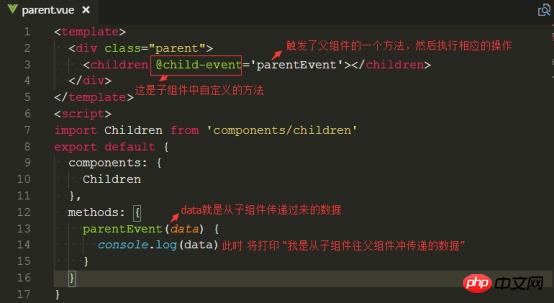
4. Transfer values between different components through eventBus (use eventBus for small projects with few pages, and use eventBus for large projects with many pages) vuex)
① Define a new vue instance specifically for passing data, and export

② Define the passed method name and Transmit content, click event or hook function trigger eventBus.emit event
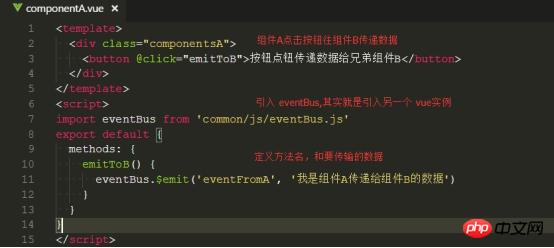
③Receive the passed data
Note: enentBus is another new Vue Instance, distinguish the two vue instances represented by this

5. Vuex passes the value
Why use vuex?
Vuex is mainly for data interaction. It is easy to pass values between parent and child components, but it is easy to pass values between sibling components (there are parent and child components under sibling components), or large spa single page framework. There are many projects and pages, and the value transfer is nested layer by layer, which is extremely troublesome. It will be very convenient to use vuex to maintain shared status or data.
Requirements: There are two components A and B. The public data maintained by vuex is the name of the restaurant resturantName. The default restaurant name is Feige Restaurant. So now the A and B pages display Feige Restaurant. If A changes the restaurant name to Restaurant A, the page B will display Restaurant A, and vice versa. The same goes for B's modification. This is the charm of vuex maintaining public status or data. If the data is modified in one place, it will become this data in other pages of the project.


①First create a sotre folder and maintain it separatelyactions mutations getters

②Create a new vuex store instance in the index.js file
*as means to import all the contents in this file, so there is no need to import each instance.
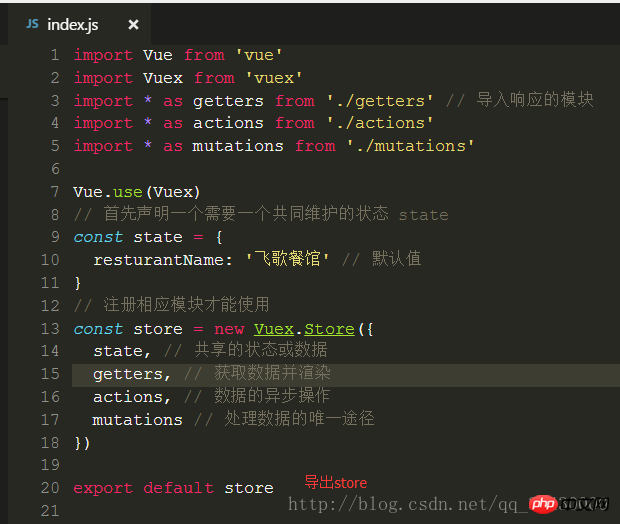
③在main.js中导入 store实例

④在组件A中,定义点击事件,点击 修改 餐馆的名称,并把餐馆的名称在事件中用参数进行传递。
...mapactions 和 ...mapgetters都是vuex提供的语法糖,在底层已经封装好了,拿来就能用,简化了很多操作。
其中...mapActions(['clickAFn']) 相当于this.$store.dispatch('clickAFn',{参数}),mapActions中只需要指定方面即可,参数省略。
...mapGetters(['resturantName'])相当于this.$store.getters.resturantName
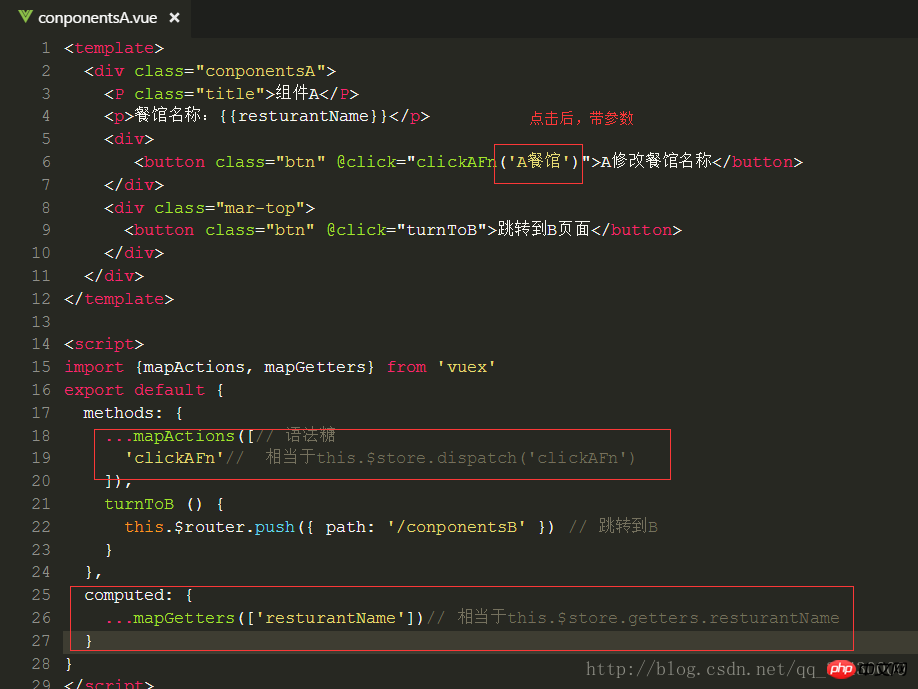
B组件同理
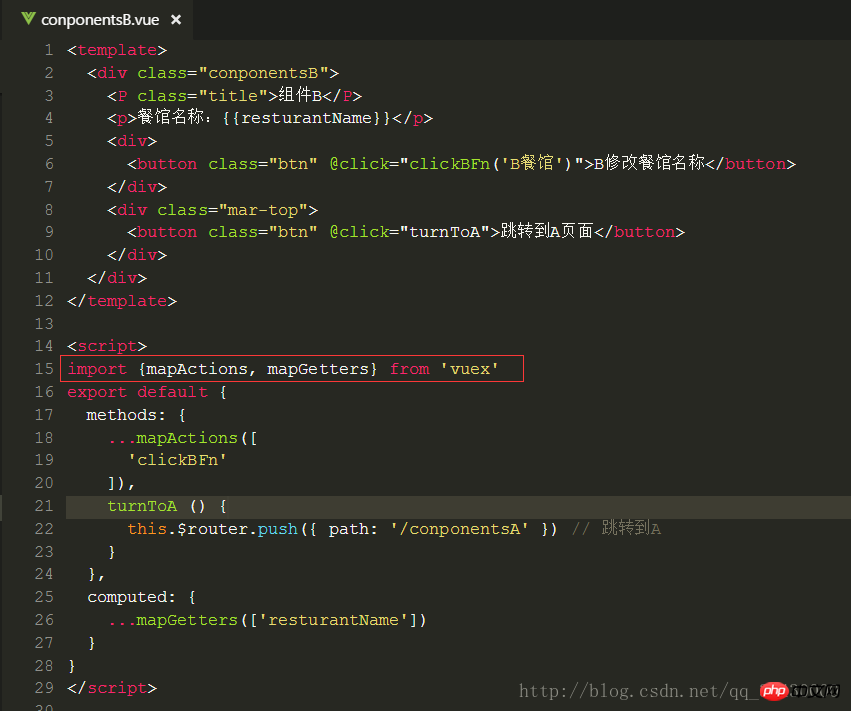
⑤actions中的操作,为了方便理解,ES6的箭头函数换成了比较好理解的函数,commit提交到mutations中

⑥mutations,mutations值所有vuex步骤中唯一能改变数据的操作,在其他步骤修改都是非法的。
在此步骤中,把组件中传递过来的 餐馆名称赋值给了vuex共同维护的状态 resturantName,这时所有的resturantName都变成了餐馆A

⑦在getter中获取最终的状态

⑧在计算属性中,渲染最终的数据 resturantName
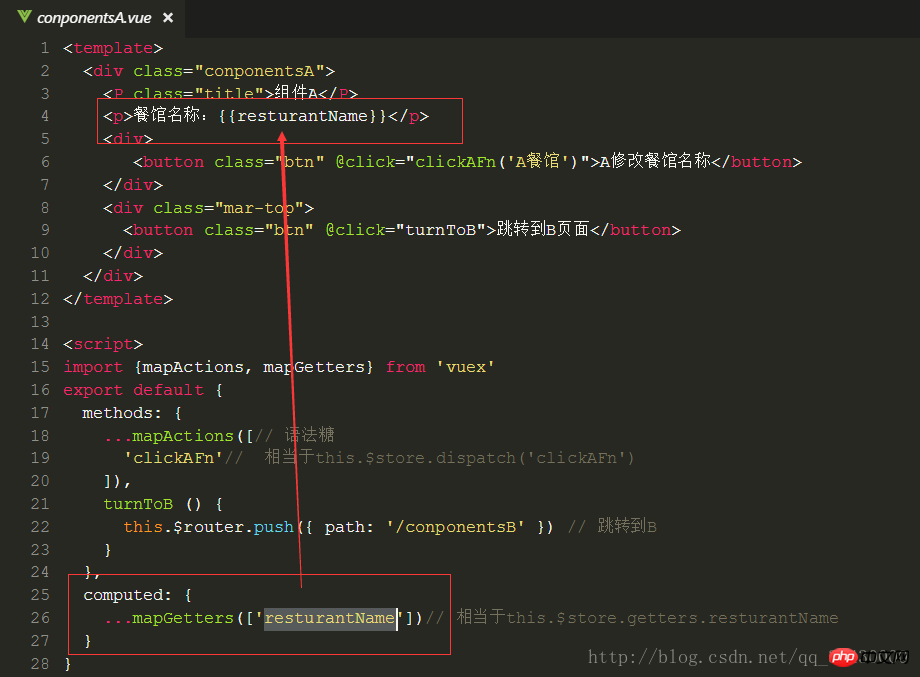
上面是我整理给大家的,希望今后会对大家有帮助。
相关文章:
在vue中使用$emit时,父组件无法监听到子组件的事件如何实现?
The above is the detailed content of How to implement value passing and communication in vue2.0 components. For more information, please follow other related articles on the PHP Chinese website!

Hot AI Tools

Undresser.AI Undress
AI-powered app for creating realistic nude photos

AI Clothes Remover
Online AI tool for removing clothes from photos.

Undress AI Tool
Undress images for free

Clothoff.io
AI clothes remover

Video Face Swap
Swap faces in any video effortlessly with our completely free AI face swap tool!

Hot Article

Hot Tools

Notepad++7.3.1
Easy-to-use and free code editor

SublimeText3 Chinese version
Chinese version, very easy to use

Zend Studio 13.0.1
Powerful PHP integrated development environment

Dreamweaver CS6
Visual web development tools

SublimeText3 Mac version
God-level code editing software (SublimeText3)

Hot Topics
 How to use bootstrap in vue
Apr 07, 2025 pm 11:33 PM
How to use bootstrap in vue
Apr 07, 2025 pm 11:33 PM
Using Bootstrap in Vue.js is divided into five steps: Install Bootstrap. Import Bootstrap in main.js. Use the Bootstrap component directly in the template. Optional: Custom style. Optional: Use plug-ins.
 How to add functions to buttons for vue
Apr 08, 2025 am 08:51 AM
How to add functions to buttons for vue
Apr 08, 2025 am 08:51 AM
You can add a function to the Vue button by binding the button in the HTML template to a method. Define the method and write function logic in the Vue instance.
 How to use watch in vue
Apr 07, 2025 pm 11:36 PM
How to use watch in vue
Apr 07, 2025 pm 11:36 PM
The watch option in Vue.js allows developers to listen for changes in specific data. When the data changes, watch triggers a callback function to perform update views or other tasks. Its configuration options include immediate, which specifies whether to execute a callback immediately, and deep, which specifies whether to recursively listen to changes to objects or arrays.
 What does vue multi-page development mean?
Apr 07, 2025 pm 11:57 PM
What does vue multi-page development mean?
Apr 07, 2025 pm 11:57 PM
Vue multi-page development is a way to build applications using the Vue.js framework, where the application is divided into separate pages: Code Maintenance: Splitting the application into multiple pages can make the code easier to manage and maintain. Modularity: Each page can be used as a separate module for easy reuse and replacement. Simple routing: Navigation between pages can be managed through simple routing configuration. SEO Optimization: Each page has its own URL, which helps SEO.
 How to reference js file with vue.js
Apr 07, 2025 pm 11:27 PM
How to reference js file with vue.js
Apr 07, 2025 pm 11:27 PM
There are three ways to refer to JS files in Vue.js: directly specify the path using the <script> tag;; dynamic import using the mounted() lifecycle hook; and importing through the Vuex state management library.
 How to return to previous page by vue
Apr 07, 2025 pm 11:30 PM
How to return to previous page by vue
Apr 07, 2025 pm 11:30 PM
Vue.js has four methods to return to the previous page: $router.go(-1)$router.back() uses <router-link to="/" component window.history.back(), and the method selection depends on the scene.
 How to use vue traversal
Apr 07, 2025 pm 11:48 PM
How to use vue traversal
Apr 07, 2025 pm 11:48 PM
There are three common methods for Vue.js to traverse arrays and objects: the v-for directive is used to traverse each element and render templates; the v-bind directive can be used with v-for to dynamically set attribute values for each element; and the .map method can convert array elements into new arrays.
 How to jump to the div of vue
Apr 08, 2025 am 09:18 AM
How to jump to the div of vue
Apr 08, 2025 am 09:18 AM
There are two ways to jump div elements in Vue: use Vue Router and add router-link component. Add the @click event listener and call this.$router.push() method to jump.





